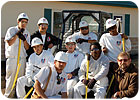.jpg)
Created in the 1960s by the Lyndon B. Johnson administration as part of the “War on Poverty,” 40 years later, Job Corps continues to enjoy strong bi-partisan support in Congress. It continues its mission to help young men and women fulfill their life’s potential, and it may just be part of your solution to meeting the demand for skilled labor in today’s transitional labor market…
The Job Corps was modeled after the highly successful 1930s Civilian Conservation Corps (“CCC”) that provided emergency relief to the nation’s poor and homeless and helped lead us out of the Great Depression. Many of the 122 facilities Job Corps uses to house and train approximately 60,000 poor young people annually are old CCC camps located in national forests and parks. Others are situated on decommissioned or excess military bases. Dormitory-style shelter, food, clothing, basic health care, academic and vocational training are provided to the trainees, all between the ages of 16 and 24.
Those who enroll in Job Corps come from a wide array of circumstances. Many have turned 18 and have “aged-out” of the foster care system without the skills to live a self-sufficient life. Others are from inner cities or remote rural communities that cannot offer them the opportunity to break a cycle of poverty they may have been born into. All are considered “at-promise” in the eyes of Job Corps counselors and instructors, and it is their job to lead them to self-sufficiency. This is accomplished through mentoring, role-modeling, academic achievement, and developing the ethic of work and the skills of a marketable trade. The Job Corps is operated by the U.S. Department of Labor and is available only to U.S. citizens and legal residents.

The Training Experience
Once enrolled, new trainees experience a 30-day process of career exploration and academic testing to determine reading and math levels before developing a career plan. They meet with career counselors and get to shadow other trainees in a variety of occupations that are offered at their location. Not every Job Corps Center offers the same selection of trades, but just about all of them offer a variety of career technical training programs related to construction, automotive, healthcare, culinary arts, information technology, and business clerical.Once the assessments are complete, the trainee selects a trade and begins career technical training classes 8 hours a day, 5 days a week. The program is designed to not only train the technical skills of a specific job, but to also develop successful work habits. Their days begin at 5 a.m., when they clean and tidy their dorm, and then head off to the mess hall for breakfast. Trainees who have not completed high school may attend academic classes for one week and then switch to a vocational or career technical training class the next. This back-and-forth scheduling continues until the trainee completes their high school diploma requirements or obtains a GED certificate.
Job Corps has a zero-tolerance policy on violence and illicit drugs, and violators are immediately removed from the premises and given a bus ticket back home. Job Corps facilities have the look and feel of a cross between a military boot camp and a university campus. Social life includes after-hours studies, sports and recreation, field trips and lectures by motivational speakers who have overcome disadvantages to become successful in their career and in their life.
Job Corps contracts with various unions and national apprenticeship training programs, known as National Training Contractors, to provide instructors and modern industry curricula classes. These entities are very much like a sub-contractor providing specialized skills to complement the Job Corps experience. The construction shops are equipped with modern equipment and commonly used hand tools of their trade.

Learning the trade
The trainee begins their introduction to the industry by learning tool identification and industry terminology, completing an OSHA 10 safety course, and using the hand tools on mock-up settings in the shop. Once some rudimentary experience is established with the hand tools, the trainee moves up to develop their new-found talents on real work, often rehabbing Job Corps buildings or working on community projects such as Habitat for Humanity. Just recently, Job Corps trainees built 13 entire homes in just six weeks with Habitat for Humanity in Lafayette, La. Materials for these homes were sponsored by a donation from Major League Baseball and they were presented to families who had fled Hurricane Katrina.Job Corps offers a self-paced curriculum; trainees graduate only when they have accomplished all of the benchmarks laid out for them by the industry and vocational training specialists. The average length of stay in Job Corps is just under one year, but trainees may choose more than one trade to complete or they may continue their formal education; either choice may lengthen the experience by as much as two years or more. I always thought if one was going out on their own, finishing a course in both plastering and cooking made a lot of sense–but that’s me, I like to eat when I get done working! Someone else might want to complete both carpentry and welding to prepare to become a lather; or painting and business clerical and then take a community college course in estimating. The potential and diversity of options is almost limitless.
Placement counselors help graduates identify employment opportunities and arrange connections with employers. In other words, they help graduates meet people like W&C readers! The graduate’s success is monitored for an entire year after they gain their first job; Job Corps offers continued career counseling even after the initial training has been completed to maximize success rates.
Walls and Ceilings Industry
Some Job Corps programs teach the basics of carpentry, interior plaster, drywall, EIFS, painting, wallpapering, metal stud framing, lathing, and stucco. Graduates of these programs are eagerly seeking entry-level opportunities in the walls and ceiling industry. They come prepared with work clothing, personal safety equipment (i.e., boots, hard hat, safety glasses, etc.), an OSHA 10 safety certificate, basic hand tools and the skills to use them, and most importantly - they are “hungry”. They have spent nine months to a year in training to earn the chance to work on your job site.How often do we find entry or apprentice level workers coming to us already able to use a hawk and trowel or a knife and pan? How many couldn’t find a gang box or a darby if it smacked them up side the head? Graduates of the Plastering, Carpentry, and Painting Job Corps programs know their way around a job site and can be productive for a contractor right out of the box. They are not journey-level tradesmen by any means… not yet anyway. But they are eager, prepared, and ready to meet the challenges of our highly competitive industry.

Take Advantage of the Opportunity
• Job Corps is a federal program and is absolutely free to both the participating trainee and any employer who may wish to hire a Job Corps graduate.• If you know someone between the ages of 16 and 24 who could benefit from such an opportunity, they do not have to become a plasterer, lather, or a drywaller to enroll (although we could use some more good applicants). The trainee is able to select the trade that is best suited for them. They will discover their future career as their program experience evolves and they begin to make a series of educated and informed choices.
• Applicants must pass a drug-screening exam and prove citizenship or legal residency status before being accepted into Job Corps.
• Job Corps trainees must meet specific but wide ranging financial criteria. The program encourages any interested person to apply and find out if they qualify, as there are different ways one can qualify for the program. As an example, a person who has been in foster care, or who completed military service, or whose parents are poor, have dropped out of high school, or they are trying to live on their own and are unemployed and earning under the poverty level. These are but a few of the ways to become eligible for the program.
• To qualify to hire a Job Corps graduate one must operate a legitimate company, provide industry standard wages, workers compensation insurance, and be willing to take a chance on someone–a chance that may pay both you and them big dividends.
As I travel around the country speaking to various groups about these opportunities, men and women who want to share stories of their Job Corps experience often approach me. A few years ago I was speaking with such a group in Las Vegas. Afterwards a Hispanic gentleman in his 50s came up to me and said, “I’ve been in the trade for 30 years; if it hadn’t been for Job Corps, I probably would have been dead before I was 30.” W&C
Resources
• To help enroll a young person in Job Corps call: 800-733-JOBS
• To hire a graduate for the lath, plaster, and drywall trades call: 800-424-5111
• To hire a graduate for the painting, glazing and drywall trades call: 202-637-0742
• Job Corps Website: http://jobcorps.dol.gov/





Report Abusive Comment